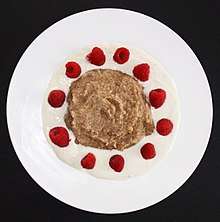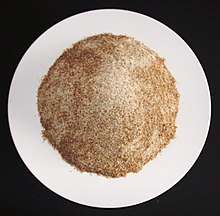Brenntar
Brenntar[1] or Habermus or Schwarzer Brei was a Swabian staple foodstuff, particularly prominent in the Swabian Jura and in the Allgäu. It is made of roasted flour, usually spelt flour or oat flour. This kiln-dried flour is called Musmehl.[2] It is usually cooked like a porridge with water and milk. Brenntar and Musmehl are closely related to the Tibetan staple food tsampa.
 Brenntar with vanilla sauce | |
| Type | Porridge |
|---|---|
| Place of origin | Germany (Swabia) |
| Main ingredients | Flour (usually spelt) |

The name Brenntar means literally 'burned porridge' and Schwarzer Brei means 'black porridge'. That is perhaps ironic, because Brenntar is brown, if everything is done correctly. However, the flour can also turn black if roasted too long in the drying kiln.
History
It is written in the Schwäbisches Wörterbuch that in 1540 the population on the Swabian Jura was saved from starvation by Brenntar[3] and Hildegard of Bingen recommended Habermus for a healthy living.[4]
In the last decades, Brenntar has almost fallen into oblivion, but has been rediscovered in the trend of conscious nutrition.
Nowadays, Brenntar and the Musmehl have been included in the Ark of Taste, Germany, as "almost forgotten regional-type food" by the Slow Food Deutschland Organization.[3][5]
Preparation
As a former convenience food used on a daily basis, Brenntar is quite simple to prepare. Originally the Musmehl was cooked in water only, spiced with salt. Today, there are different recipes for Habermus, for example, mixed with vegetables or sweet with fruits.
See also
- Tsampa, a Tibetan staple food also made from roasted flour
- List of porridges
References
- Barbara Ehlert: Getreide – die Grundlage unserer Zivilisation. I: Die Allgäuerin, 2010/3, S. 32/33 (PDF)
- Bentele, Josef (2012-07-31). Berichte aus vergangenen Tagen: Erinnerungen eines Westallgäuers an die „gute alte Zeit“ (in German). BoD – Books on Demand. ISBN 978-3-8448-4071-1.
- "Musmehl in der Slowfood-Arche". Archived from the original on 2016-05-01. Retrieved 2017-08-20.
- Peter Pukownik: L'approche thérapeutique au quotidien d'Hildegarde de Bingen. 2017. ISBN 978-2853275514 p.40
- General-Anzeiger, Reutlinger. "Wieso Sie Musmehl mal kosten sollten". www.gea.de (in German). Archived from the original on 2017-08-20. Retrieved 2017-08-20.
Further reading
- Aegidius Kolb, Leonhard Lidel : D' schwäbisch' Kuche, 18. Auflage, 2017. ISBN 978-3928934022 (Swabian cuisine)